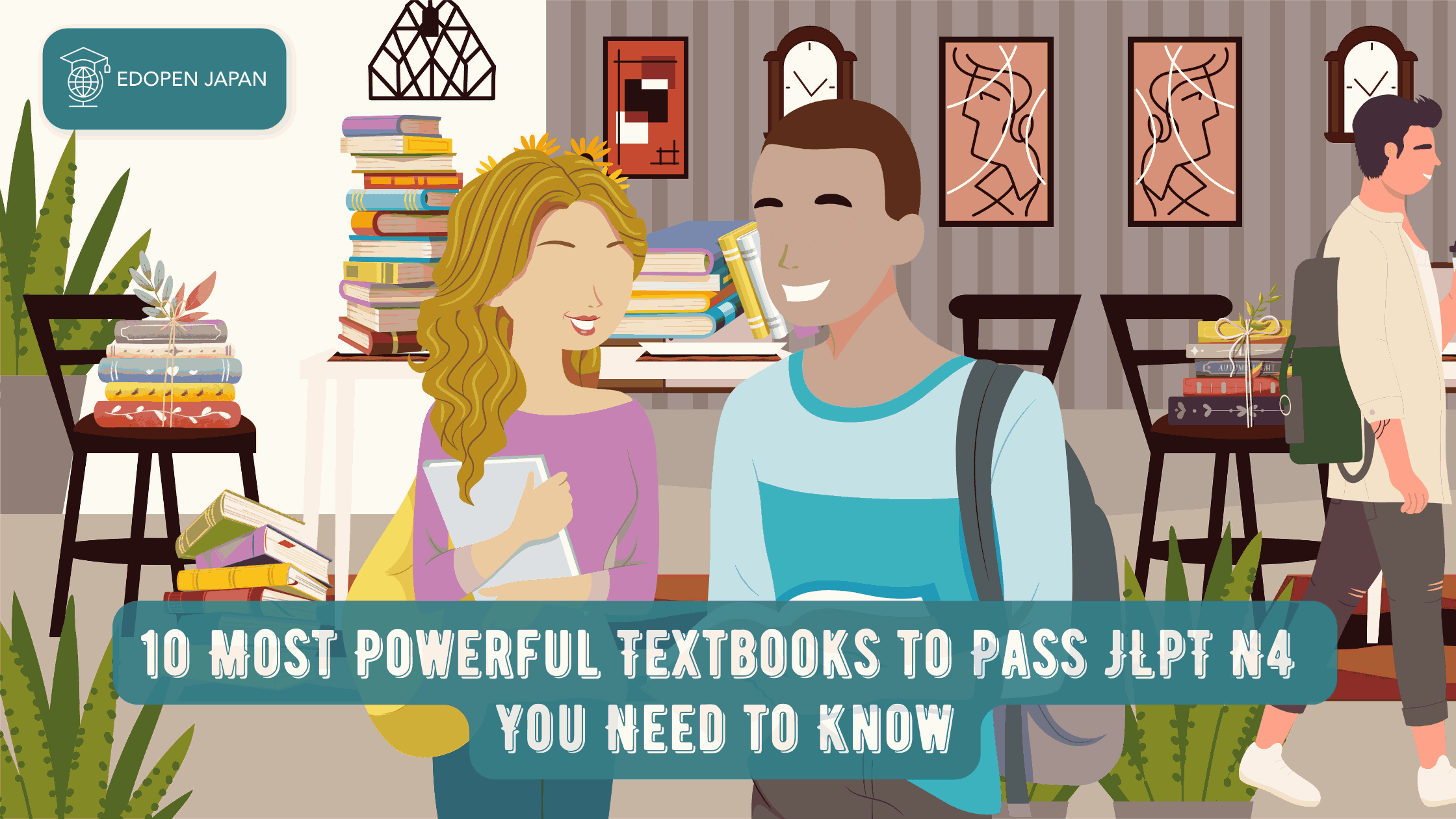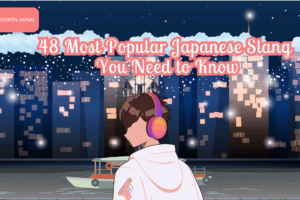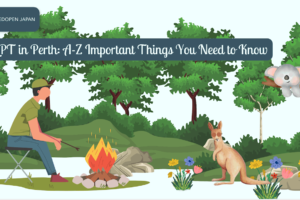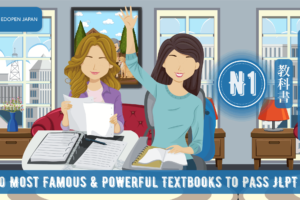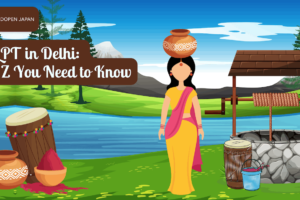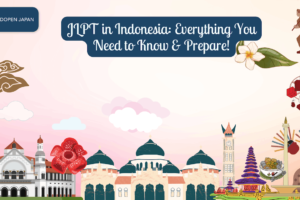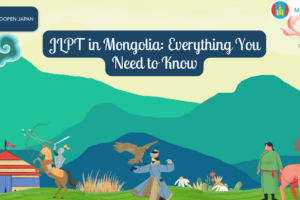JLPT certification is mandatory for non-native speakers who wish to work or study in Japan. Achieving JLPT certification grants special opportunities while residing in Japan. Moreover, the certification is categorized into predetermined levels, thus requiring suitable study materials to master it effectively.
This article will cover the top 10 most powerful books to prepare for the JLPT N4 exam, which is the second-lowest level on the JLPT scale after N5. We hope you will continue to read our articles to expand your understanding of the JLPT. After reading this article, we look forward to your comments and feedback below.
In order to broaden your knowledge and achieve mastery of the JLPT and especially the JLPT N4, please peruse our comprehensive guide provided below.
Read also:
The Most Complete JLPT N4 Kanji List
JLPT N4 Vocabulary | The Most Complete List
Contents
About JLPT N4 Exam

JLPT N4 assesses basic Japanese comprehension, at a higher level than N5. Like the JLPT N5, it evaluates learners’ comprehension of Japanese in five distinct areas as follows:
| 1. Grammar (文法/bunpou) |
| 2. Vocabulary (語彙/goi) |
| 3. Kanji (漢字/kanji) |
| 4. Reading Comprehension (読解力/dokkai ryoku) |
| 5. Listening Comprehension (聴解力/Chōkai ryoku) |
In addition, the JLPT N4 test has three sections: language knowledge, other language
knowledge with reading, and listening comprehension. Refer to the following section for further details.
(1) Language Knowledge (30 minutes)
In the language knowledge section, you will be tested in 5 aspects as follows:
| 1. Kanji Reading | Test reading words written in kanji. |
| 2. Orthography | Test kanji for words written in hiragana. |
| 3. Contextually-defined expressions | Test words whose meaning is apparent from the context. |
| 4. Paraphrasaes | Test words and expressions with similar meanings. |
| 5. Usage | Test the use of words in sentences. |
(2) Language Knowledge & Reading (60 minutes)
Then, in the language knowledge and reading comprehension section, you will be evaluated on your grasp of grammar and ability to comprehend written text.
| 1. Sentential grammar 1 (selecting grammar form) | Test your judgment about grammar formats that go with sentences. |
| 2. Sentential grammar 2 (sentence composition) | Test a syntactically correct and meaningful sentence structure. |
| 3. Text grammar | Test judgment about the suitability of sentences for text flow. |
| 4. Comprehension (short passages) | Test your understanding of the content by reading a simple original text of about 100-200 characters on topics and situations from your studies, everyday life, and job. |
| 5. Comprehension (mid-size passages) | Test your understanding of the content by reading a simple original text of about 450 characters on topics and situations of daily life. |
| 6. Information retrieval | Test the ability to extract necessary information from original materials such as notices (approx. 400 characters). |
(3) Listening (35 minutes)
In the third section, you will undergo a listening comprehension test to assess your understanding of the concepts conveyed via spoken expressions, as outlined below:
| 1. Task-based comprehension | Test understanding of content by listening to a coherent text (test ability to extract the necessary information to solve specific problems and understand appropriate actions). |
| 2. Comprehension of key points | Test understanding of content by listening to a coherent text (test ability to narrow down points based on necessary information presented in advance). |
| 3. Verbal expressions | Test the ability to choose appropriate verbal expressions by listening to the circumstances while looking at the illustrations. |
| 4. Quick response | Test the ability to select the appropriate answers by listening to short utterances such as questions |
Grammar Drill JLPT N4

The aim of the JLPT N4 grammar section is to comprehend approximately 55 grammar rules. The grammar encompasses the levels of upper elementary and intermediate Japanese. Precisely, your grasp and usage of the subsequent rules will be assessed as follows. Please read the list of the following top two books below to master JLPT N4.
| 1. Basic particles usage and their application. |
| 2. Basic grammatical structure and word form. |
| 3. Formal and casual conjugations of verbs and adjectives. |
| 4. Forms of verbs and adjectives in past and present tense. |
1. Minna no Nihongo Series
Minna no Nihongo is a highly regarded Japanese textbook for school courses, non-beginner Japanese learners, and individuals worldwide. Minna no Nihongo offers two levels: beginner and intermediate. Each level consists of two volumes and other extensive companion books. The Minna no Nihongo series is the official name for these resources.
| 1. Minna no Nihongo Beginner I (初級 I – Shokyū I) |
| 2. Minna no Nihongo Beginner II (初級 II – Shokyū II) |
| 3. Minna no Nihongo Intermediate I (中級 I – Chūkyū I) |
| 4. Minna no Nihongo Intermediate II (中級 II – Chūkyū II) |
Especially for JLPT N4, we recommend intensive study of Minna no Nihongo Beginner II (初級 II – Shokyū II) and all related materials. If you have not yet completed Minna no Nihongo Beginner I (初級 I – Shokyū I) and its complementary materials, please finish those before advancing to the next level.
According to the majority of JLPT N4-N5 participants, completing Minna no Nihongo Beginner I-II should adequately prepare you for JLPT N4 and N5. Nonetheless, we recommend supplementing your studies with practice questions from other JLPT textbooks, which we will also provide.
2. Dictionary of Japanese Grammar Series
If you wish to gain a thorough understanding of the JLPT N4, utilize this grammar dictionary as a preparation tool. It contains comprehensive coverage of not only JLPT N4 but also JLPT N3 at the fundamental and intermediate levels.
The Dictionary of Japanese Grammar features three distinct series, each differentiated by its level – basic, intermediate, and advanced. Regardless of the level, every series contains comprehensive explanations in both English and Japanese. The explanations include intricate details like the following:
| 1. A Dictionary of Basic Japanese Grammar | 200 grammatical concepts that form the basis of the Japanese language. |
| 2. A Dictionary of Intermediate Japanese Grammar | about 200 grammatical terms that form the intermediate level of the Japanese language. |
| 3. A Dictionary of Advanced Japanese Grammar | 230 grammatical rules that form the advanced level of the Japanese language. |
Kanji & Vocabulary Drill JLPT N4

To pass the JLPT N4, you must master roughly 1500 vocabulary words and 300 kanji characters. The JLPT N4 vocabulary list comprises 1500 nouns, verbs, and adjectives, as well as foreign language absorption words in katakana.
On the flip side, to pass JLPT N4 Kanji, you must master 200 additional kanji compared to JLPT N5. The tested kanji at N4 level encompass a slightly wider range of subjects than those at the N5 level.
1. Kanji Tamago: Pre-Intermediate
Kanji Tamago’s book is an essential resource for exploring commonly used kanji in daily life. With this book, you can acquire the necessary knowledge to pass JLPT N5 and N4 with ease. Kanji Tamago has two book series, one for beginners and another for pre-intermediate learners.
The pre-intermediate series is ideal for those preparing for the JLPT N4 exam. The book features the following content:
| 1. 15 chapters with comprehensive kanji explanations. |
| 2. Writing exercises and visuals |
| 3. 4 additional training units and CD for listening practices. |
2. Kanji Master JLPT N4
If you enjoy quizzes and want to learn kanji in a structured and engaging way to pass JLPT N4, this book is ideal for you. This book is part of a larger series that covers all of the JLPT tests.
The Kanji Master JLPT N4 book includes 9 chapters focused on topics relevant to everyday life, which could potentially appear on the JLPT N4 test. The Kanji Master JLPT N4 book contains:
| 1. 9 units on different topics. |
| 2. Translation in English, Chinese and Vietnamese. |
| 3. Lots of activities and exercises, practice test, as well as fun quiz game |
3. Elementary Kanji Workbook or Flashcards (1026 kanji)
To excel at all levels of the Japanese Language Proficiency Test, including JLPT N4, one must possess skill in kanji mastery. For effective mastery, practice is crucial. We recommend the workbook “Elementary Kanji or Flashcards (1026 Kanji)” to assist with the JLPT N4 and higher levels.
The Elementary Kanji Workbook includes:
| 1. 1026 Kanji, each page with a new set of kanji. |
| 2. Sentences and phrases for practice. |
| 3. The pages can be cut into flashcards to practice the kanji. |
Do JLPT N4 Practice Test with Complete Set Books

To pass the JLPT N4, consistent practice is the ultimate key to success. Most importantly, cover all the aspects that will be assessed to prepare adequately. Below we recommend complete book sets for JLPT fighters. These books are highly regarded and have received excellent reviews.
All the books listed below consist of complete sets for every level of the JLPT exam ranging from N5 to N1. They comprise an ample number of questions making them super comprehensive and easy to review. Please choose one of the complete sets of your JLPT N4 preparation book below!
1. New Kanzen Master JLPT N4
New Kanzen Master is a special book series for JLPT exam preparation at all levels. You can get 5 books in 1 book set. In 1 set of New Kanzen Master of JLPT N4 you will get:
| 1. New Kanzen Master JLPT N4: Grammar | This book focuses on grammar, sentence structure, and explanations of the basic forms of verbs also adjectives, and their correct use in sentences. |
| 2. New Kanzen Master JLPT N4: Listening Comprehension | You will learn how to process information from longer segments. |
| 3. New Kanzen Master JLPT N4: Reading Comprehension | The book will help you master long sentences, unlock the meaning of unfamiliar words, understand text structure, and read different types of texts. |
| 4. New Kanzen Master JLPT N4: Kanji | You will learn 278 kanji at the N4 level. This book will help you to grasp how each Kanji is used in the actual situation with the theoretical side of kanji. |
| 5. New Kanzen Master JLPT N4: Vocabulary | Each chapter consists of a basic exercise and a practical exercise section. Using this book, you can test your skills with questions in the same format as the actual exam. |
2. Nihongo So-Matome JLPT N4
If you want to do JLPT N4 preparation exercises with daily lessons, the complete set of Nihongo So-Matome JLPT N4 books is perfect for you. Similar to the previous book, Nihongo So-Matome is also a set of books specifically for JLPT preparation at all levels. For JLPT N4 level, Nihongo So-Matome has 2 books, as follows:
| 1. Nihongo So-Matome JLPT N4: Kanji and Words | If you study using this book consistently at 2 pages/day, you will be able to learn the 200 kanji characters and 300 Japanese vocabulary words found in both daily life and the JLPT N4 in just six weeks! |
| 2. Nihongo So-Matome JLPT N4: Reading, Grammar, and Listening | This book contains 42 daily reading, grammar, and listening comprehension lessons in Japanese with practice and review tests with answers. Also an audio CD for pronunciation practice. |
3. JLPT N4 Official Practice Workbook
This book is highly recommended for those who want to practice the JLPT N4 under real JLPT test conditions. This book contains:
| 1. 34 questions on vocabulary and kanji with objectives that can be solved in 30 min. |
| 2. 25 grammar and 10 reading questions with targets that can be solved in 50 min. |
| 3. 21 listening comprehension questions to be solved in 35 min. |
4. Speed Master JLPT N4
If you already have a strong understanding of the JLPT N4 material but want to increase the speed of answering the questions, then this 1 book set of Speed Master JLPT N4 books is perfect for you. In 1 complete set, you will get 4 books as follows:
| 1. Speed Master JLPT N4: Reading |
| 2. Speed Master JLPT N4: Grammar |
| 3. Speed Master JLPT N4: Listening |
| 4. Speed Master JLPT N4: Vocabulary |
5. Drill and Drill JLPT N4
If you have a limited budget but still want to have the best book to practice JLPT N4, this JDrill and Drill JLPT N4 book will be very helpful for you. This book is also specially made with questions that are very similar to the original JLPT N4 test. The answers and discussions given were very complete.
Conclusion
Finally, We’d like to ask you to review the 10 Most Powerful Textbooks again to Pass JLPT N4 that we’ve described above. The following are the 10 best books for mastering JLPT N4 according to each competency tested plus a set of JLPT N4 practice exams.
| Grammar Drill of JLPT N4 | 1. Minna no Nihongo Series 2. Dictionary of Japanese Grammar Series |
| Kanji & Vocabulary Drill of JLPT N4 | 1. Kanji Tamago: Pre-Intermediate 2. Kanji Master JLPT N4 3. Elementary Kanji Workbook or Flashcards (1026 kanji) |
| JLPT N4 Practice Test | 1. New Kanzen Master JLPT N4 2. Nihongo So-Matome JLPT N4 3. JLPT N4 Official Practice Workbook 4. Speed Master JLPT N4 5. Drill and Drill JLPT N4 |
We also appreciate any comments and suggestions for our improvement. We wish you success in passing JLPT N4! Insights other than the technical aspects of JLPT will also help you develop a deeper understanding of Japanese learning. Therefore, please always check our lates update here!

